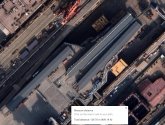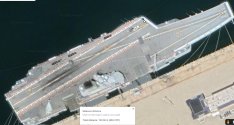It surely is possible.I think it is possible to make such upgrade.
Like Ulyanovsk, if Liaoning and Shandong only use EMAL to lunch KJ-600 and heavy-loaded J-15 for strike mission, the EMAL may not need high sortie rate. They can slowly power up the super capacitor or the fly wheel for electricity storage, it can still work, though not as good as Fujian, still better than nothing.
However, as we do not have any concrete information on the power output of the powerplants onboard Liaoning and Shandong, so the best I could do is just fondling on best guesses.
Speaking of which, I think it would be better for me to just do some measuring on Google Maps. Do note that the values are, at most, approximation.
Firstly, the Fujian.

The length of the EMALS catapult from the front end to the edge of the JBD is around 125 meters.
If we install the same EMALS catapult onto the waist of Shandong, then it would be as following:

Notice that even if we put the front end of the same EMALS catapult right at the edge of the waist deck, the rear end of the EMALS catapult (with or without the JBD) would still interfere with the front arresting cable system.
Refer to the picture in my previous post #8411. Notice how the waist catapult on Fujian does not intersect with the arresting gear system.
Unless the PLAN managed to find a way to shorten the length of the EMALS catapult system significantly, it would be a no go for a waist EMALS catapult on both Liaoning and Shandong.
So, the EMALS catapult system is an exclusivity for the flat-deckers, unfortunately. Sorry, ski-jumpers.
By the looks of it, it isn't really feasible, for similar above reasons.I agree Liaoning is probably out of discussion, it is just an experimental CV, China does not even recognize it as CV back in 2012. But for Shandong, if China has planed to upgrade it with EMAL when designing it, it will be feasible. It was not news that Ski jump is inferior to EMAL back in 2006. China should have considered it.
Furthermore, in the eyes of the PLAN, both Liaoning and Shandong are experimental. The real deal starts with Fujian.
Don't worry, China isn't Russia.Shandong will need a mid-life retrofit sooner than later, adding one EMAL is probably cheaper than building a brand new CV.
Today's China has plenty of money to throw around for the PLA and related military R&D institutions and universities, backed by a sizeable military budget, which itself is backed by the 2nd largest nominal GDP in the world (or largest if you refer to PPP terms).
Plus, China's current military budget is just 1.7% of its nominal GDP. Looking at the current US' 3.7% and the Reagan's era of 5-6%, I can confidently say that China's stomach for her military budget is far from being full.
Last edited:
